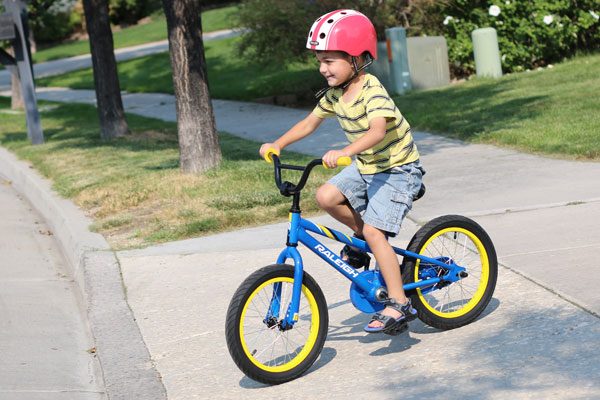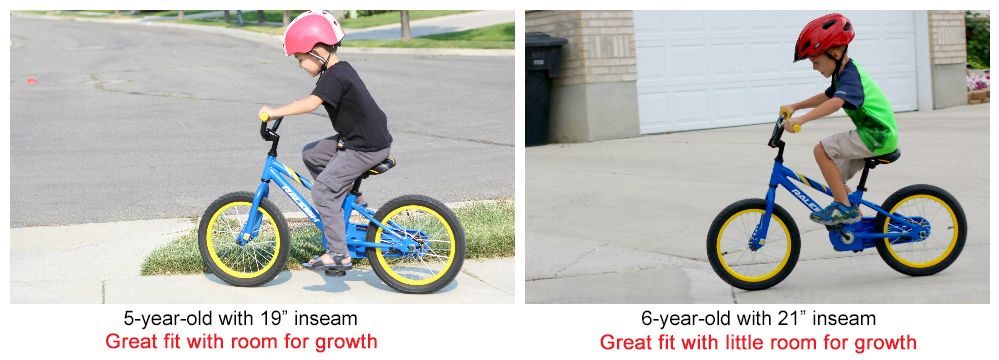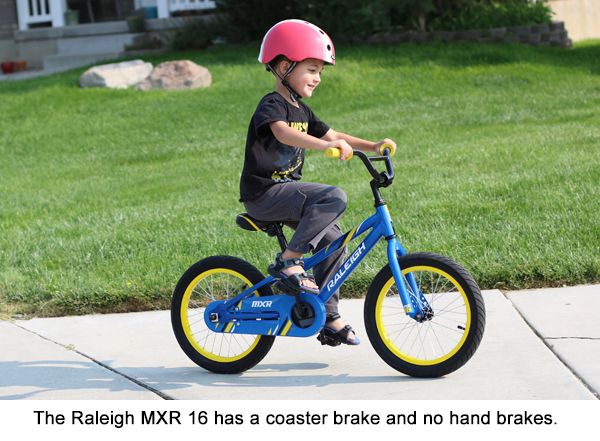The Raleigh MXR 16 is a well-made budget bike for kids 4 to 6. With a more upright body position and a coaster brake, it’s better suited for basic neighborhood riders. Read our review to find out why its a great buy over other budget bikes!

Raleigh MXR 16

RATING: Recommended
MSRP: Discontinued
BEST FOR: Neighborhood riders looking for a fun, durable, and reliable basic bike.
SEAT HEIGHT: 19.5″ – 24″
WEIGHT: 18.3 lb.
BRAKES: Coaster Brake only
ADDITIONAL SPECS
FRAME: Aluminum Alloy
GAIN RATIO: 3.5
WHEELBASE: 725 mm
STANDOVER HEIGHT: 16″
PROS:
- Lightweight for the price and size
- Comfortable upright geometry for neighborhood riders
- Durable and essentially maintenance-free
- Available in green and blue
CONS:
- Coaster brake, no hand brake
- Tall minimum seat height for a 16″ bike
- Effort needed to start pedaling
Raleigh MXR 16 Review – Results of Our Test Rides
The Raleigh MXR 16 is a fun, reliable bike that will surely be loved by the average child enjoying new found freedom on their rides around the neighborhood. A basic build with a coaster brake, no hand-brakes, and standard components, the MXR isn’t top-of-the-line, but for $170 it’s a great bike for the price and certainly worth the extra expense as compared to big-box store $75 bikes. The MXR line is also available in 12″ and 20″ bike tire sizes.

Performance
Classically simple, the MXR brought smiles to our testers’ faces. Our 5 and 6-year-old testers were both enamored by the MXR’s bright colors and were eager to take it for a ride. Our 6-year-old tester – who is quite the ambitious rider – quickly began flying down driveways and jumping off curbs. The only complaint he had was that it took more effort than he’s accustomed to to start pedaling, but like many kids naturally do, he simply stood up to pedal and quickly gained momentum and went on his way. Standing up to help with pedaling is common with bikes in the MXR’s price range, which we’ll explain further in the gearing section below.
6-year-old Ambitious Rider on Raleigh MXR 16

Our less adventurous 5-year-old tester also enjoyed riding the MXR around the neighborhood. Accustomed to riding 16″ bikes with low-rise handlebars, his first ride was a little wobbly as he adjusted to the MXR’s higher-placed handlebars. Once he adjusted his steering, he was happily maneuvering the bike through a race track of cones he carefully laid out beforehand. Like our 6-year-old tester, getting the bike started was also a slight challenge for him, but not being advanced enough to stand up at slower speeds, he simply ran with his feet slightly longer than normal to gain momentum before be began pedaling. As mentioned previously, this is a common problem with sub $200 bikes that kids generally get accustomed to with time.
5-year-old on Raleigh MXR 16

Size
Seat Height and Standover Height
The seat height on the MXR 16 ranges from 19.5″ – 24″. With a slanted top tube and a standover height of just over 16″, a child really should have at least an 18″ inseam in order to achieve the industry recommended minimum 2″ of top tube clearance for safe riding.
The seat height range combined with the standover height make the MXR an ideal fit for kids with 18″ to 21″ inseams. The MXR was a great fit for our 5-year-old tester with a 19″ inseam and our 6-year-old tester with a 21″ inseam. How it fits your child is highly dependent on their inseam measurement and how much experience they have riding pedal bikes without training wheels, which we explain below.
Raleigh MXR Size Range

Fitting a Bike: First Time Pedal Bike Riders
When determining a proper fit for a kids bike, it’s important to consider whether the child has already mastered riding a pedal bike without training wheels. For first-time pedal bike riders (balance bike graduates), it’s best to have the seat height set to the child’s inseam so they can safely start and stop the bike with their feet flat on the ground. With the MXR’s minimum seat height of 19.5″, a first-time pedal bike rider needs to have at least a 19.5″ inseam to ride the bike.
Fitting a Bike: Experienced Pedal Bike Riders
For kids who have already mastered riding a bike without training wheels (like our two testers shown above), they don’t need to be able to stop and start the bike with their feet. The seat height should be set around 2″ above their inseam so that the child is standing on their tip toes when seated on the bike. With the MXR’s minimum seat height of 19.5″, this means that a child with an inseam as small as 17.5″ can comfortably ride the bike. (Although based on standover height, we recommend 18″.) As a result, while Raleigh gives the age recommendation of 3 to 5 for the MXR 16″, we believe it would be a better fit for kids aged 4 to 6.
Fitting a Bike: Training Wheels
Unlike many of the 16″ bikes we’ve reviewed, the MXR does come with training wheels. While we strongly encourage the use of balance bikes to teach a child to balance a bike, we understand that training wheels may be the best option for some families. When using training wheels, the seat height should be set 2″ to 3″ above the child’s inseam to provide proper leg extension when pedaling. So with the MXR’s minimum seat height of 19.5″, this would allow kids starting with inseams of 16.5″ to 17.5″ to ride. However, once again because of the standover height, we recommend a minimum inseam of 18″.
Growing with the MXR
While the ideal inseam range for riding the MXR 16 is from 18″ – 21″, kids with inseams ranging from 21″ – 23″ can also fit on the bike, but the bike will provide little, if any, room for growth. The MXR’s taller handlebars, however, do allow a child to comfortably continue to ride the bike with the seat set to its maximum height of 24″.
Since kids ages 4 to 6 often grow very quickly, it’s common to see kids riding 16″ bikes that are technically too small for them. Many parents don’t want to buy a new bike every year while their kid is growing like a weed! So while we wouldn’t recommend it, we’re also realistic about what is really going to happen 🙂 – a child with an inseam of up to 24″ or even 25″ could easily ride the MXR, but they would be cramped on the bike and would be unable to properly extend their legs with each pedal stroke.
To check seat height ranges and get more 16 inch bike options, head over to our list of Best 16 inch bikes for kids.
Brakes

The MXR 16 only comes with coaster brakes (back pedal brakes). Although coaster brakes have the advantage of being essentially maintenance free, they can be problematic for beginning riders.
When learning to ride a bike, kids naturally pedal backward when they lose their balance. On a bike with coaster brakes, this natural motion unexpectedly activates the brake, which often causes the unsuspecting child rider to lose their balance further and fall off the bike. This learning process, however, is temporary as kids quickly learn to adapt to the coaster brake. Essentially all 16″ pedal bikes under $200 come with coaster brakes, so while not ideal, it isn’t an issue worth skipping the MXR 16 over.
If you are willing to spend a little more to get a bike without a coaster brake, the Raleigh Rowdy 16 and the Raleigh Lily 16 are both coaster brake free.
Geometry
The MXR 16 is designed for the average neighborhood rider and therefore has higher-rise handlebars to provide a more comfortable upright body position. Kids, especially beginning riders, are generally more comfortable gaining and maintaining their balance on a bike when their body weight is positioned over their hips, like when standing or walking. Higher handlebars allow kids to sit more upright and therefore center more of their body weight over their hips.
As a comparison, the Raleigh Rowdy 16″, which has the same frame as the Raleigh MXR 16″, is designed for more aggressive riders who need to be able to shift their body weight around on the bike when going over jumps, down curbs, etc. As a result, the handlebar on the Rowdy is flat, which requires the child to lean in to grab the handlebars, which better positions them to shift their weight for aggressive and adventurous riding.
MXR’s Higher Handlebars Often Preferred by Beginning and Everyday Riders

Pedal Power (Gain Ratio and Components)
The gain ratio of a bike determines how hard it is to start pedaling, and how fast and easily it can gain speed. Like the gears in a car, the lower-gears are much easier to get started with, but higher-gears allow you to travel faster. With a 3.5 gain ratio, the MXR is geared pretty average for a 16″ bike (gain ratios range from 2.8 to 4.5).
A bike with a lower gain ratio has the advantage that it’s easier to start to pedal but it requires more spinning of the wheels to gain speed. Higher gain ratios require more effort to get the pedals moving but require less spinning of the tires to gain speed. Most 16″ bikes (even $300+ bikes) are geared in the mid-3’s (not too high and not too low) because it’s the best for the average neighborhood bike rider.
Compared to similarly geared 16″ bikes, however, the MXR was slightly harder for our testers to get started. While there are several factors at play, the bike’s components – including the pedals, chain, bottom bracket, and all the parts that help to move the back tire – are likely to play a role.
With essentially all bikes, both for kids and adults, the quality of these components can drastically change the overall price of a bike. Higher-end bikes use higher-end components which help to make a bike easier to start pedaling, but your budget would have to jump up to at least a $250 price tag. For $170, however, the MXR components are well suited for the average child rider and much more durable and reliable than lower-end, big-box store bikes which were even more difficult for our testers to get started.
As a result, we believe the MXR 16 would be an amazing second pedal bike for kids growing out of their 12″ or 14″ bikes, but the effort needed to start the bike may be a turn off for some first-time riders. If you want to minimize the potential frustration with a first-time rider, buying a higher-end 16″ bike ($250+, such as the Priority Start 16 or the woom 3) would be to your advantage. The higher-quality components and more kid-friendly design of these bikes have helped our testers build their confidence and skill level on a bike much faster than bikes in the $175 and below range.
In fact, often times spending more money on a 16″ bike than your child’s future 20″ bike is to your benefit. Once confidence and basic skills have been learned, the average neighborhood child rider generally does just fine on a more budget, sub $175 20″ bike. That being said, buying a bike out of your budget is NOT required to teach your child to ride a bike! Kids’ bikes have historically been challenging to learn to ride, yet kids have successfully learned to ride them for decades :).
Comparison
In its price range, the MXR 16 is a great choice. While not as light as the Diamondback Mini Viper, we found it to have slightly better components and it’s also much easier to come by (the Diamondback Viper can be hard to find). At $179, REI’s REV 16″ is lighter, but its narrow handlebars can be problematic for larger framed kids.
Raleigh MXR 16 Comparison
| Bike | Raleigh MXR 16 | Guardian Ethos 16 | REI Co-op REV 16 |
|---|---|---|---|
| MSRP | $249 | $179 | |
| Best for: | The average neighborhood rider. | Kids who want the best braking system on the market. | Smaller framed kids who would benefit from narrow handlebars. |
| Seat Range | 19.5" - 24.5" | 18.5" - 23.5" | 21" - 25" |
| Handlebars | Mid/High-rise | Mid/High-rise | Mid-rise, narrow |
| Brakes | Coaster, no hand brake | SureStop brakes, no coaster | Coaster, no hand brake |
| Weight | 18.3 lb. | 17.5 lb. | 17.5 lb. |
| Gain Ratio | 3.5 | 3.55 | 3.5 |
Raleigh MXR 16 Bottom Line
If you’re looking to spend under $175 on your kid’s bike, the Raleigh MXR 16 is a solid choice. Durable, fun, and essentially maintenance free, the MXR 16 is worth the price jump from big-box-store bikes costing around $75. Although it’s better suited as a second bike for those already experienced with riding a pedal bike, the Raleigh is lightweight enough for ambitious first-time riders eager to ride.
FTC Disclosure: Affiliate links are included in this review. No monetary compensation was provided for this review, however, the reviewed product was supplied by the manufacturer or distributor to help facilitate this review. All opinions and images are that of Two Wheeling Tots LLC. All content and images are copyrighted and should not be used or replicated in any way. View our Terms of Use.
